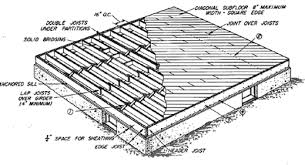joist
英 [dʒɔɪst]
美 [dʒɔɪst]
- n. 托梁;搁栅
- vt. 为…架搁栅;为…装托梁
- n. (Joist)人名;(德)约伊斯特
星级词汇:

中文词源
joist 托梁
来自古法语giste,桥梁支撑梁,托梁,来自拉丁语iacere,扔,投掷,引申词义躺,搁,词源同gist,jet,gist.
英语词源
- joist
-
joist: [14] Etymologically, a joist is a wooden beam on which boards ‘lie’ down. The word’s ultimate ancestor is the Latin verb jacēre ‘lie down’ (from which English also gets adjacent). Its neuter past participle jacitum was taken into Old French as a noun, giste, which denoted a ‘beam supporting a bridge’ (its modern French descendant, gîte ‘home’ – that is, ‘place where one lies down’ – is currently infiltrating English). Middle English took over the Old French word, which from the 15th century gradually began to change to joist.
=> adjacent - joist (n.)
- early 14c. (late 13c. in Anglo-Latin), from Old French giste "beam supporting a bridge" (Modern French gîte), noun use of fem. past participle of gesir "to lie," from Latin iacere "to lie, rest," related to iacere "to throw" (see jet (v.)). Notion is of wooden beam on which boards "lie down."
权威例句
- 1. The transverse diaphragm is very similar in appearance to the conventional bar joist.
- 横梁很相似于通常的钢筋搁栅.
- 2. A triangular metal bracket used to strengthen a joist.
- 用于加固托梁的金属板.
